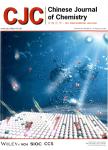Synthesis,Structure and Magnetic Behavior of a Novel Series of Trinuclear Windwheel Complexes
作者机构:Key Laboratory of Marine Chemistry Theory and TechnologyMinistry of EducationCollege of Chemistry and Chemical EngineeringOcean University of ChinaQingdaoShandong266100 China Baotou Research Institute of Rare EarthsBaotouInner Mongolia014040 China State Key Laboratory of Physical Chemistry of Solid SurfacesCollege of Chemistry and Chemical EngineeringXiamen UniversityXiamenFujian361005 China
出 版 物:《Chinese Journal of Chemistry》 (中国化学(英文版))
年 卷 期:2023年第41卷第24期
页 面:3662-3668页
核心收录:
学科分类:081704[工学-应用化学] 07[理学] 08[工学] 0817[工学-化学工程与技术] 070303[理学-有机化学] 0703[理学-化学]
基 金:supported by the Natural Science Foundation of Shandong Province(No.ZR2021QB140) the Fundamental Research Funds for the Central Universities(No.202113051) F.S.thanks the Youth Talent Project support(Nos.202001013196,202101013108)from Ocean University of China the Open Project support(No.202017)from the State Key Laboratory of Physical Chemistry of Solid Surfaces Xiamen University and the Open Project support(No.M202317)from the State Key Laboratory of Microbial Technology,Shandong University
主 题:Cluster compounds Crystal growth Magnetic properties Slow magnetic relaxation Magnetic anisotropy
摘 要:A new family of trinuclear windwheel complexes with molecular formula [M^(II)_(3)(tpa)_(3)(μ-ttc)](ClO_(4))_(3)·n(sol) (ttc = 1,3,5-triazine-2,4,6-trithiol;tpa = tris(2-pyridylmethyl)amine;M = Mn,n = 2,sol = CH_(3)CN,1;M = Co,n = 1,sol = CH_(3)CN,2;M = Ni,n = 0,3) were synthesized and ***-crystal X-ray diffraction revealed that three metal centers in 1—3 are connected by ttc bridge,forming a regular triangular MII3 *** metal center is bonded by chelating S,N atoms from ttc and by N atoms from *** studies showed that 1—3 displayed antiferromagnetic behavior and further gave the easy-axis anisotropy (D = −0.77 cm^(−1) for 1 and −8.13 cm^(−1) for 2) and easy-plane anisotropy (D = 5.08 cm^(−1) for 3).Moreover,2 exhibited field-induced slow magnetic relaxation behavior and their effective energy barriers were roughly evaluated Ueff = 6.9 K.



